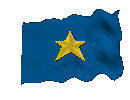The World Book Encyclopedia
Continental Congress was a convention of delegates from the
American Colonies that first met in Philadelphia on Sept. 5,
1774. The meeting grew out of a desire of unity which had
spread through the colonies. All the colonies saw danger to
themselves in the acts of Parliament aimed against
Massachusetts, especially the Boston Port Bill. See Boston
Port Bill.
The First Continental Congress was attended by 56
delegates representing 12 colonies. Georgia sent no delegates
but agreed to support any plans made at the meeting. Leaders of
the Congress included Samuel Adams, George Washington, Peyton
Randolph, Patrick Henry, Richard Henry Lee, John Adams, John
Jay, Joseph Galloway, and John Dickinson. Peyton Randolph of
Virginia was chosen president of the Congress, and each of the
12 colonies had equal voting power.
The first Congress was more interested in fair treatment
from Great Britain than in independence. It set forth the
position of the colonies toward taxation and trade in a
Declaration of Rights, adopted on Oct. 14, 1774. The Congress
recognized that it was not practical for the colonies to seek
representation in Parliament. But it claimed the right of each
colonial assembly to draw up its laws on all subjects except
foreign trade.
Probably the boldest act of the Congress was to set up
the Continental Association, which bound the colonists not to
trade with Great Britain or use British goods until British
trade and taxation policies had been changed. The delegates
made plans to hold another Congress the following May, if
necessary.
Second Continental Congress. British colonial policy
did not change, and the colonies drew close to war with the
fighting between Massachusetts farmers and English troops at
Lexington and Concord. The Second Continental Congress met in
Philadelphia on May 10, 1775. New delegates of note were
Benjamin Franklin, Thomas Jefferson, and John Hancock. The
Congress took on the duties of a government, uniting the
colonies for the war effort. An army was organized and George
Washington was appointed commander in chief. On July 8, 1775,
the Congress issued a declaration setting forth the need to take
up arms and the reasons for doing so. Two days later, it made
a final, futile appeal to the king in an effort to right matters
without going to war.
With the outbreak of war, the Second Continental
Congress encouraged the colonies to set themselves up as states.
On July 4, 1776, it adopted the Declaration of Independence.
Then it set about drawing up an outline for a permanent union
of states which resulted in the Articles of Confederation. The
second Congress operated under great difficulties, because it
was a group without legal authority except when it acted with
the consent of the states. It continued to work until March 1,
1781, when a Congress authorized by the Articles of
Confederation took over. This Congress was known as the Congress
of the Confederation, but many persons continued to use the name
Continental Congress for it.
In addition to
Peyton Randolph, who served as president twice, the presidents of the
Continental Congress were:
Henry Middleton,
John Hancock,
Henry Laurens,
John Jay,
Samuel Huntington,
Thomas McKean,
John Hanson,
Elias Boudinot,
Thomas Mifflin,
Richard Henry Lee,
Nathaniel Gorham,
Arthur St. Clair, and
Cyrus Griffin.
-- John R. Alden
See also Articles of Confederation; Congress of the
Confederation; Continental Association; Declaration of
Independence.
Additional Resources
Burnett, Edmund C. The Continental Congress. Greenwood,
1975, First published in 1941.
Montross, Lynn. Reluctant Rebels: The Story of the
Continental Congress, 1774-1789. Harper, 1950.






